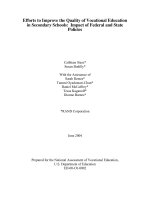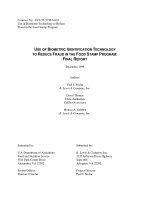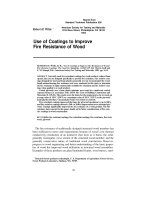use of coatings to improve
Bạn đang xem bản rút gọn của tài liệu. Xem và tải ngay bản đầy đủ của tài liệu tại đây (381.48 KB, 16 trang )
Reprint from
Standard Technical Publication 826
Robert H. White
1
American Society for Testing and Materials
1916 Race Street, Philadelphia, PA 19103
1984
Use of Coatings to Improve
Fire Resistance of Wood
REFERENCE: White, R. H., “Use of Coatings to Improve Fire Resistance of Wood,”
Fire Resistive Coatings: The Need for Standards, ASTM STP 826,
Morris Lieff and
F. M. Stumpf, Eds., American Society for Testing and Materials, 1983. pp.
24-39.
ABSTRACT
Currently used tire retardant coatings for wood products reduce flame
spread; they are not designed specifically to provide fire resistance. Fire resistive coat-
ings designed for steel and foam plastics generally are not recommended for wood.
Small nonload-bearing fire resistance tests were conducted in this study to determine
the fire resistance of eight commercially available fire retardant and fire resistive coat-
ings when applied to a wood product.
Coated plywoods over a foam plastic substrate were tested in a small-scale vertical
exposure furnace in accordance with ASTM Fire Tests of Building Construction and
Materials (E 119-82). The results were the times for the temperature rise to reach an
average value of 139°C (250°F) or a maximum value of 181°C (325°F) at the plywood/
foam-plastic interface. Uncoated plywoods were tested as controls.
Fire retardant coatings improved the times for plywood specimens by up to 900 s,
and fire resistive coatings showed a 240- to 2640-s improvement over uncoated ply-
wood. Coatings significantly improved the tire resistance of a wood product. The fire
resistance data reported in this paper should aid in future considerations of fire resis-
tive coatings in wood construction.
KEY WORDS:
fire resistant coatings, fire retardant coatings, fire resistance, fire tests,
wood, plywood
The fire resistance of traditionally designed structural wood members has
been sufficient to meet code requirements because of wood’s low thermal
conductivity; production of an insulative char layer as it burns; the solid,
generally rectangular, cross section of the structural wood member; and the
generally conservative nature of traditional wood construction. However,
progress in wood engineering and better understanding of the basic proper-
ties of wood has improved wood utilization in structural wood assemblies.
Examples of these products are glued laminated beams, wood trusses, sand-
1
Research forest products technologist, U. S. Department of Agriculture Forest Service,
Forest Products Laboratory, Madison. Wis. 53705.
24
WHITE ON FIRE RESISTANCE OF WOOD 25
with panels, glued plywood beams, and prefabricated wood joists [ 1 ]. In
these and similar applications, there may be a need to improve fire endur-
ance. In addition, changes in the occupancy of a building or new require-
ments in the building codes may increase the required fire resistance rating in
an existing structure.
Fire resistive coatings add fire resistance to the substrate. Fire resistance is
the property of a material to withstand fire or give protection from it. Fire
resistance of elements of buildings is characterized by the ability to confine a
fire or to continue to perform a given structural function or both. Commer-
cial coatings have been available for some years to improve the fire resist-
ance of structural steel. More recently, they have been developed for foam
plastics. However, no coatings specifically designed for improving the fire
resistance of wood are currently available. Fire retardant coatings provide
comparatively low flammability or flame spread properties to the substrate.
Flashover, or the sudden simultaneous ignition of most combustibles in a
room, signals the start of a fully developed fire. Existing coatings for wood
are fire retardants that reduce flame spread in the preflashover fire mode, as
opposed to fire resistant coatings that improve fire endurance of the pro-
tected substrate beyond the time of flashover.
Existing published data on the fire resistance of coated wood are limited
and inconclusive. Coated wood beams or columns have been tested in Eu-
rope and Japan to determine the effect of coatings on rate of charring [ 2-5 ].
Sandwich panels with and without mastic fire resistive coatings have been
tested for fire endurance [ 6 ]. In Canada, a wood floor and ceiling assembly
coated with cementitious material on an expanded metal lath and a mastic
coating have a 1½-h unrestrained assembly rating [ 7 ]. In most cases, only
one specimen of a given coating was tested. Thus, statistically reliable data
that conclusively evaluate the effect of fire retardant or fire resistive coatings
on the fire resistance of wood are not available in the published literature.
In recent years, building codes have required foam plastics to be fully pro-
tected from the interior of the building by a thermal barrier. This thermal
barrier must limit the average temperature rise of its unexposed surface to
139°C (250°F) for at least 900 s of fire exposure in accordance with ASTM
Fire Test of Building Construction and Materials (E 119-82). This study on
coatings is a follow-up to a previous study on wood-based panel products as
possible thermal barriers [
8,9
].
The objective of the work reported here was to obtain performance data
showing the effect of coatings applied to a wood product in improving the
fire resistance. Four fire retardant coatings and four fire resistive coatings
(Table 1) were evaluated for their ability to improve the fire resistance of
plywood. All coatings were commercially available. It is hoped that the re-
sults of this work will encourage the development of fire resistive coatings
specifically formulated for wood.
26
FIRE RESISTIVE COATINGS
As in previous tests [8], the plywood was tested over a foam-plastic sub-
strate in a small vertical furnace. Satisfactory performance was based on the
times until the 139/181°C (250/325°F) temperature rise criteria of ASTM
Method E 119-82 were satisfied at the interface of the plywood and the foam
plastic.
Different thicknesses of coatings were tested on three thicknesses of ply-
wood as shown in Table 2. Most tests were replicated three times. The origi-
nal experimental design included:
(1) one thickness of four fire retardant coatings on nominal 16-mm
(%-in.)
plywood,
(2) two thicknesses of four tire resistive coatings on nominal 16-mm
(%-in.)
plywood,
(3) one thickness of one fire retardant coating on nominal 6- and 19-mm
(¼- and ¾-in.) plywood,
(4) one thickness of one fire resistive coating on nominal 6- and 19-mm
(¼- and ¾-in.) plywood, and
(5) uncoated nominal 6-, 16-, and 19-mm (¼-,
%-,
and ¾-in.) plywood.
Preparation of the Specimens
Plywood specimens were conditioned to equilibrium moisture content at
23°C (73°F) and 50% relative humidity before coatings were applied. After
WHITE ON FIRE RESISTANCE OF WOOD 27
the coatings were applied, specimens were reconditioned for a minimum of
30 days. The differences in weight and thickness between the specimen before
coating and the coated specimen at the time of testing were recorded as the
dry coating weight and the dry coating thickness.
The 508- by 508-mm coated-plywood specimen and a foam-plastic slab
were screwed to a wood frame (Fig. 1). Five 30-gage iron-constantan thermo-
couples were attached to the unexposed side of the plywood. Thermocouples
were located at the center of the panel and at the center of each quadrant.
Materials
The eight coatings
2
are described in Table 1. Coatings were selected so a
range of different types of coatings was tested. Coatings A through D are fire
2
The use of commercial products in this study was for the convenience of the government.
Such use does not constitute an official endorsement or approval by the U.S. Department of
Agriculture of any product or service to the exclusion of others that may be suitable.
28
FIRE RESISTIVE COATINGS
retardant coatings designed to reduce the flame spread of wood substrates as
measured in the ASTM Test for Surface Burning Characteristics of Building
Materials (E 84-77). The fire resistive coatings were designated as Coatings E
through H. Coating E is designed to halt fire propagation in grouped electri-
cal cables. Coatings F, G, and H are designed to provide thermal or fire pro-
tection to steel or foam plastics.
The sanded southern pine plywood was graded “PS 1-74, Exterior, A-C,
Species Group 1.”
The average measured thicknesses of the nominal 6-, 16-,
and 19-mm (¼-,
Y“-,
and ¾-in. ) plywood panels were 7.3, 16.2, and 19.1 mm,
respectively. The plywood had an oven-dry density of 460 ± 60 kg/m
3
and
moisture content of 8.7 ± 0.7%.
The foam-plastic slabs were cut from nominal 25.4-mm (l-in.) foam-plastic
sheathing. The sheathing had a glass-reinforced polyisocyanurate foam-
plastic core with aluminum foil facings, The foam-plastic sheathing had an
R-value of 1.3 m
2
· K/W and density of 32 kg/m
3
.
WHITE ON FIRE RESISTANCE OF WOOD 29
Equipment
The vertical furnace (Fig. 2) has a 508-mm square opening into which the
specimen was inserted. The furnace is equipped with pipe outlets for dis-
charging natural gas into the furnace. Air for combustion was admitted by
natural draft through vents at the bottom of the furnace and was distributed
with a baffle. A single iron-capped time-temperature curve monitoring
thermocouple was located inside the furnace opposite the center of the spec-
imen and 51 mm from the exposed surface of the specimen. The thermo-
couple was located closer to the specimen than the 152 mm specified in
30
FIRE RESISTIVE COATINGS
ASTM Method E 119-82. This was necessary if the thermocouple was to be
located between the specimen and the natural gas pipe outlets. It was as-
sumed that this has no appreciable effect on the results.
Test Procedure
The gas supply of the furnace was regulated so the temperature of the iron-
capped thermocouple followed the ASTM Method E 119-82 time-tempera-
ture curve during the test. The test was continued until all of the thermocou-
ples at the plywood foam-plastic interface had recorded at least a 139°C
(250°F) rise in temperature. An average rise of 139°C (250°F) is one of the
limiting performance criteria. The specimen was observed during the test
through the two observation ports on the sides of the furnace (Fig. 2).
Results
Numerical Results
For each test, the time was noted when the five thermocouples attached to
the unexposed side of the plywood recorded an average temperature rise of
139°C (250°F) and when any one thermocouple recorded a 181°C (325°F)
WHITE ON FIRE RESISTANCE OF WOOD 31
temperature rise. The lesser of the two times is reported as the total time. The
mean total times for the four fire retardant coatings on 16-mm
(%-in.)
ply-
wood ranged from 780 to 1580 s (Table 2). The mean total times for the four
fire resistive coatings on 16-mm
(?4-in.)
plywood ranged from 930 to 3320 s
(Table 3). The coefficients of variation for the replicated tests were 10% or
less. On average, the coated specimens have a significantly higher total time
than the uncoated specimens. Individually, all the coated specimens except
the single coat of Coatings A or B were significantly better than the uncoated
control specimens. The uncoated 16-mm
(%-in.)
plywood had an average
time of 670 s.
The difference between the endurance time for the coated specimen from
the time for the uncoated specimen, which was cut from the same sheet of
plywood, was calculated as the improvement caused by the coating. For the
four fire retardant coatings, the average improvement with respect to the un-
coated 16-mm
(%-in.)
plywood ranged from 120 to 920s (Table 2). The im-
provement for the four fire resistive coatings on 16-mm
(%-in.)
plywood
ranged from 250 to 2640 s (Table 3).
The average improvements of coated over uncoated plywood increased
with the thickness of the plywood.
Visual Observations
Observations of the specimens during the tests were difficult because the
natural gas flames from the burner often obscured the view of the specimens.
The fire retardant coatings were intumescent coatings that expanded to a
thick foamy layer when exposed to heat. For the thicker multiple coated
specimens, an increase in thickness up to 75 mm was observed, When the ex-
pansion was substantial, the foam would sometimes slip from the top to the
bottom of the vertical specimen or fall off the specimen. While substantial
parts of the foam sometimes fell off, the base of the foam layer remained at-
tached to the plywood. After continued exposure to the fire, the rest of the
foamy layer burned away or fell off. Less expansion was observed on speci-
mens protected with one coat. No expansion of Coating B was noticed when
only one coat had been applied. In contrast, 75 mm of intumescence was ob-
served with five coats of Coating B.
The main observation with some of the fire resistive coatings was failure of
the adhesion of the coating to the plywood. Small blisters formed on the sur-
face of Coating E, and the coating would crack and parts would come off as
the test progressed. Coating F either came loose from the plywood or burned
away. Coating G remained intact during the test but was not attached to the
plywood when the specimen was removed from the furnace after the test.
Coating H expanded and remained attached to the plywood.
Comparison of Results
On average, the fire resistive coatings have a significantly higher total fire
resistance time than the fire retardant coatings. The fire resistive coatings
were thicker coatings than the fire retardant coatings. Fire retardant coatings
are only expected to reduce flame spread. The Duncan’s multiple-range sta-
tistical test was used to rank the total times for the different types of speci-
mens (Fig. 3). Specimen types were grouped together if their mean results
were not significantly different. Because the ranking depends upon the
thickness of the coating, it is not a ranking of the different coatings.
Effect of Coating Thickness
Performance of a coating improved as the thickness of the coating was in-
creased as shown in Figs. 4 and 5 and Table 4. For fire retardant Coatings A
and B, and fire resistant Coatings E, F, G, and H, the increase in time per
increase in coating thickness was calculated for replicated data at two thick-
nesses. The difference in the means for the two thicknesses was statistically
significant for each of the coatings.
The increase for fire retardant Coating D is based on singular tests at five
coating thicknesses. Based on the variability of other replicated 6-mm (¼-in.)
34
FIRE RESISTIVE COATINGS
plywood tests, the difference between the 0. l-mm-thick and the 0.5-mm-thick
Coating D is significant.
For comparison.
the increase in time for the uncoated plywood was
70-s/mm increase in the thickness of the plywood.
Effect of Plywood Thickness
In the statistical evaluation of the total times, the plywood thickness by
treatment interaction term suggested that the coatings behaved differently
on different thicknesses of plywood. This is also shown in the data for the
improvements obtained with the coatings. The improvement of the coated
plywood with respect to the uncoated plywood increased with an increase in
the thickness of the plywood (Fig. 6). See Table 5.
This is because the coatings provide an insulative layer over the plywood
WHITE ON FIRE RESISTANCE OF WOOD
35
in addition to delaying the ignition and charring of the plywood. An insula-
tive layer will reduce heat transfer into the substrate. As a result, the time for
a temperature rise at a given location in the substrate will be increased. The
longer the total time, the longer the insulative layer will improve the per-
formance of the specimen. Because the temperature is recorded at the unex-
posed side of the plywood, thicker plywood specimens increase the total ex-
posure time. Thus, the improvement shown for insulative coating will
increase as the thickness of the plywood is increased.
In addition to plywood thickness, other methodology factors, such as sub-
strate, orientation of specimen, and size of specimen may affect the results.
The amount and type of insulation behind the plywood has an effect on the
results [ 8 ]. In previous tests, the results were greater for uncoated plywood
when tested over calcium silicate than when tested over foam plastics [ 9 ].
36
FIRE RESISTIVE COATINGS
Tests were conducted on vertical specimens only. Floor ceilings and other
horizontal specimens are generally tested for fire exposure from below.
Thus, a horizontal orientation of the specimen may have a detrimental effect
on results for coated plywood when there is poor cohesion or adhesion of the
coating. The 9-m
2
fire-exposed area required by ASTM Method E 119-82 for
performance of protective membranes in wall assemblies would better test
the ability of a protective membrane or thermal barrier to remain in place
than did the small-scale tests performed in this study.
Discussion
Fire resistant coatings have potential for use in several situations. Coatings
can be used to improve the fire endurance of the new structural wood prod-
ucts mentioned in the introduction. The coatings can improve the finish rating
of panel products used as a thermal barrier for foam plastics. In addition, the
development of analytical procedures for predicting the fire resistance of
large-timber members should make it more feasible to obtain acceptance for
fire resistive coated timber members when a specific fire rating is required.
In addition to the degree of thermal protection, there are other things to
consider before using a fire resistive coating. These include properties in areas
of (1) durability at normal temperatures, (2) durability at elevated tempera-
tures, (3) smoke and toxic gas hazard, and (4) fire spread and structural sta-
bility [ 10 ]. ASTM test standards are being developed to determine the per-
formance characteristics of sprayed-applied fireproofing [ 11 ]. Published
standards include ASTM Tests for Thickness and Density of Sprayed Fire-
Resistive Material Applied to Structural Members (E 605-77), Cohesion/
Adhesion of Sprayed Fire-Resistive Materials Applied to Structural Members
(E 736-80), Effect of Deflection of Sprayed Fire-Resistive Materials Applied
to Structural Members (E 759-80), Effect of Impact on Bonding of Sprayed
Fire-Resistive Materials Applied to Structural Members (E 760-80), and
Compressive Strength of Sprayed Fire-Resistive Materials Applied to Struc-
tural Members (E 761-80). ASTM Methods E 759-80 and E 760-80 are for a
steel substrate. ASTM Methods E 736-80 and E 761-80 are for any rigid
backing. Some considerations not directly related to thermal protection may
be important in determining the practical feasibility of using coatings such as
application temperatures, method of application, cure time, and water vapor
transmission.
The small-scale tests did not involve an applied load on the specimens.
Additional research is needed to determine performance of coatings on load-
bearing assemblies. To obtain actual in-use performance, details of the total
construction must be considered. Unprotected portions of the construction
may lead to premature failure. The effect of joints in the membrane must be
considered.
WHITE ON FIRE RESISTANCE OF WOOD
37
The development and use of fire resistive coatings in wood construction
will depend upon their cost effectiveness. The economics of applying a coat-
ing versus increasing the member cross-sectional area may particularly limit
the use of coatings on new products. Coatings are more likely to be an eco-
nomical alternative when improving the fire resistance in existing buildings.
It is hoped the fire resistance data reported in this paper will aid in future
considerations of fire resistive coatings in wood construction.
Summary
Four fire retardant coatings and four fire resistive coatings applied to AC,
Group 1 plywood were tested for fire resistance in a small vertical furnace
using the ASTM E 119-82 time-temperature curve. The coated plywood was
installed over a substrate of foam plastic. While a single coat of the fire re-
tardant coatings only produced a minimum gain of 120 s, a gain of 920 s was
achieved with multiple coats. With a 0.5-mm-thick flat, alkyd intumescent
fire retardant coating, 16-mm
(%-in.)
plywood provided a 1580-s thermal
barrier.
As expected, the fire resistive coatings provided more protection than the
fire retardant coatings. A 6.4-mm ablative, epoxy intumescent mastic coating
provided up to 2420-s improvement over uncoated plywood. With a 35-mm-
thick mineral fiber coating on 16-mm
(%-in.)
plywood, a 3320-s thermal bar-
rier (total time) was achieved.
The improvement in tire resistance provided by the coating depended upon
the type and thickness of the coating and the thickness of the plywood.
Other performance characteristics and the cost effectiveness of coatings
will need to be considered when evaluating
construction.
Acknowledgments
possible applications in wood
Avco Corporation, Carboline Company, Clark-Tectonics, Inc., Ocean
Chemicals, Inc., and Stahl Industries, Inc., provided materials used in this
study.
References
38
FIRE RESISTIVE COATINGS
DISCUSSION
DISCUSSION ON FIRE RESISTANCE OF WOOD 39









